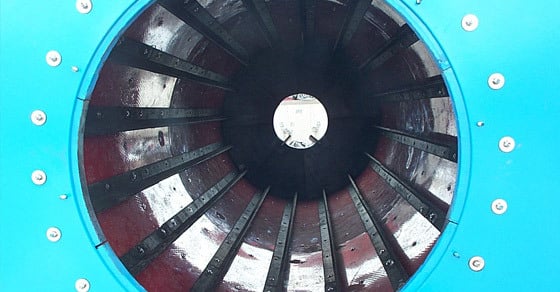Scrubbing is an integral washing step employed in the beneficiation of many types of ores and minerals, helping to remove contaminants and gangue and ultimately improve recovery of the target material. Rotary scrubbers are often used in this role; while a variety of equipment types exist for scrubbing ore, the rotary scrubber, a type of rotary drum, offers a few key advantages that have made it the preferred approach to scrubbing at many mines and quarries.
Here’s a look at how these devices work, and why many miners prefer them over alternative types of scrubbers.
The Role of a Rotary Scrubber in Ore Scrubbing (Washing)
Once ore has been extracted from the ground, scrubbing is one of the first and most important steps in the beneficiation process, indiscriminate of what’s being mined. It is typically carried out after primary crushing and involves the combination of the ore with water and agitation in order to break down and separate gangue materials.
By scrubbing the ore, undesirable components such as clays, soft rock, and loam, are removed. This helps to make the beneficiation process more efficient and allows a higher throughput by reducing the amount of non-valuable material that the rest of the operation must process. Also by removing these materials, scrubbing increases the concentration of the valuable component and promotes a better quality product.¹
In addition to these benefits, scrubbing also frequently improves downstream processing, as any clays present in the material can be problematic for some equipment and processing techniques.
Scrubbing is often used in the extraction of:
- Bauxite
- Iron ore
- Nickel & Cobalt
- Gold
- Aggregates
- Diamonds
- Potash
Due to the many benefits it offers, scrubbing can have a significant impact on the economics of a mining operation. Further, as high-grade ore deposits are tapped dry, scrubbers will become ever-more important in maximizing recovery as miners face increasing levels of gangue.
Amid the decline of high-grade ore deposits, the effectiveness of scrubbers has also seen them investigated for use in recovering material from tailings.
How a Rotary Scrubber Works
The rotary scrubber is similar to an agglomeration drum in build, consisting of a large, rotating drum set on a slight slope to help move material through the unit via gravity.
Lifter or tumbling flights are typically incorporated to provide agitation and to help uniformly disperse the clay fraction of the ore for maximum removal. Rubber or abrasion-resistant liners are often employed to protect the drum shell from abrasion.
Rubber liners can be seen on the interior of this rotary scrubber at both the drum shell end and throughout its interior (flights have not yet been installed)
Rotary scrubbers are best suited for scrubbing ores containing light clays and are typically not a fit for processing materials containing tough plastic clays.
Benefits of the Rotary Scrubber Over Other Scrubber Types
The rotary scrubber offers a few key benefits that have contributed to its widespread use over alternatives:
High Capacity
The large size of a rotary scrubber allows this scrubber type to process material at greater capacities than other types of equipment, making it the preferred approach for high-throughput operations.
Accepting of Larger Particle Size
Another key reason for which a rotary scrubber is chosen is because it can accept a much larger particle size compared to most other types of scrubbers. Depending on the type, the maximum particle size alternative scrubbers such as log washers and screw washers can handle is around 100mm, with larger log washers capable of handling particles up to 150mm. In contrast, rotary scrubbers can handle particles up to 300mm in size (as a result of this, they are sometimes employed prior to primary crushing).¹
Can Assist in Screening
Unlike other scrubber types, rotary scrubbers can be equipped with a trommel screen (also known as a grizzly) to assist in sizing. Depending on the circumstances, this may negate the need for additional screening equipment in some settings.
Reliable
Like other rotary drums, rotary scrubbers are robust machines, particularly when built to suit the unique challenges of their intended application. Combined with their simple design and operation, this long-term reliability has made them the preferred device for the rigorous demands of scrubbing.
Conclusion
Rotary scrubbers provide a high-capacity, effective option for scrubbing ores in the beneficiation process. Their ability to process larger particle sizes, combined with their screening capabilities and a reputation for reliability gives rotary scrubbers a major advantage over other types of scrubbers.
FEECO is a leading provider of rotary drums of all types, from dryers, coolers, and kilns, to scrubbers and conditioning drums. We also offer a comprehensive parts and service program to keep rotary drums performing in top condition. For more information on our rotary scrubber capabilities, contact us today!



